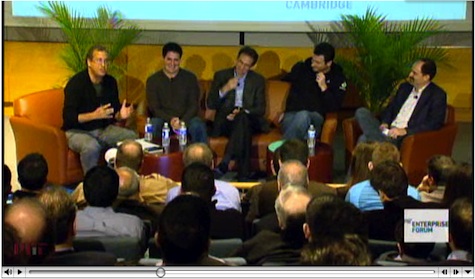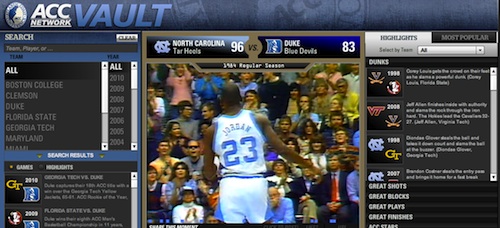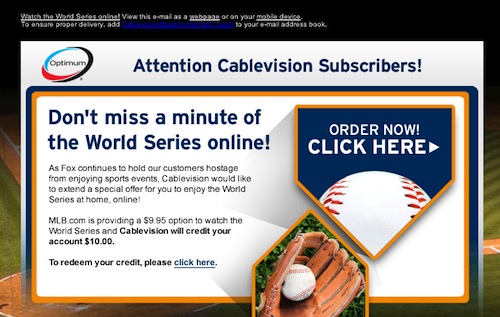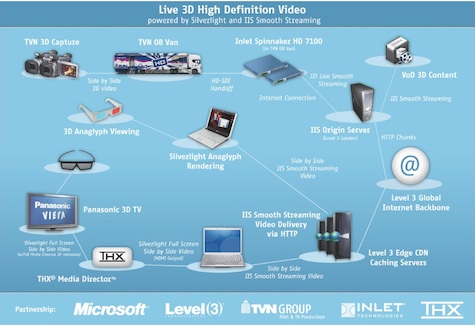-
Disney Has Religion on Digital, ESPN Is At the Core
Disney held its annual investor day yesterday, and as usual, technology, and the opportunities it creates for the company, was at center stage. Disney introduced a new initiative called "Disney Studio All Access" providing a central location for consumers to securely access the company's range of content. Though details were sketchy, key to the plan is more flexible consumer ownership and multi-device playback. For paid, downloadable video, that remains the holy grail.
introduced a new initiative called "Disney Studio All Access" providing a central location for consumers to securely access the company's range of content. Though details were sketchy, key to the plan is more flexible consumer ownership and multi-device playback. For paid, downloadable video, that remains the holy grail.
Aside from the company's digital initiatives on the entertainment side of its house, the most important asset that Disney is trying to re-imagine digitally is ESPN. Just yesterday, the company announced a new distribution deal with Verizon, which emphasizes live online streaming of ESPN, ESPN2, ESPNU and ESPN Buzzer Beater. The deal is similar to one inked last September with Time Warner Cable, the country's 2nd-largest cable operator. No doubt others will follow.
Categories: Cable Networks, Cable TV Operators, Sports, Telcos
Topics: Disney, ESPN, Time Warner Cable, Verizon
-
VideoNuze Report Podcast #88 - Feb. 18, 2011
Daisy Whitney and I are pleased to present the 88th edition of the VideoNuze Report podcast, for February 18, 2011.
In this podcast, Daisy and I discuss a deal announced earlier this week in which MLB.com will provide near real-time video clips to CBSSports.com's Fantasy Baseball Commissioner users, among other things. The deal caught my attention because the video is driven off of metadata that's created and published almost immediately after the video is shot. That contrasts with metadata creation happening with library content. The deal also speaks to the way video can be used to enhance various online experiences. Listen in the learn more.
Click here to listen to the podcast (12 minutes, 1 second)
Click here for previous podcasts
The VideoNuze Report is available in iTunes...subscribe today!Topics: CBSSports.com, MLB.com, Podcast
-
Time Warner Cable-LA Lakers Deal Is More Bad News For Pay-TV's Non-Sports Fans
If you live in the Los Angeles area and are not a sports fan, or you are a casual one, Time Warner Cable's new 20-year deal with the LA Lakers is more bad news. That's because, as I explained last week in "Not a Sports Fan? Then You're Getting Sacked For At Least $2 Billion Per Year," virtually all digital pay-TV subscribers in the LA area - sports fans or not - are going to be footing the bill for this massive deal.
The TWC-Lakers deal is just the latest example of how ever-higher monthly fees pay-TV distributors must fork over to carry sports networks help drive up subscription rates. In this case, TWC, the 2nd largest pay-TV operator, is positioning itself to also be a major sports network owner, just as Comcast has with Comcast SportsNet. TWC's deal will help create an even bigger inequity for non-sports fans and casual fans than already existed. For this group of subscribers, who are primarily entertainment-oriented, and likely more on-demand focused in their viewership than ever, higher subscription rates - tied to a small cluster of very expensive sports networks - are inevitably going to drive them to drop their pay-TV service.
positioning itself to also be a major sports network owner, just as Comcast has with Comcast SportsNet. TWC's deal will help create an even bigger inequity for non-sports fans and casual fans than already existed. For this group of subscribers, who are primarily entertainment-oriented, and likely more on-demand focused in their viewership than ever, higher subscription rates - tied to a small cluster of very expensive sports networks - are inevitably going to drive them to drop their pay-TV service.
Categories: Cable Networks, Cable TV Operators, Sports
Topics: Hulu Plus, LA Lakers, Netflix, Time Warner Cable
-
MLB.com's Near Real-Time Video Enriches CBSSports.com's Fantasy Baseball
CBSSports.com and MLB.com announced an exclusive multi-year partnership yesterday that illustrates well how video clips generated in near real-time can add significant value to online experiences. Under the deal, MLB will supply CBSSports.com's Fantasy Baseball Commissioner users with in-game video highlights on live scoring pages for every single player, as the games progress. In addition, MLB will provide a highlights package for each player so users can get a look at him before in action before drafting or trading him. Lastly, MLB will provide live audio feeds of all 2,430 regular season games. All of this is being provided at no additional charge to Commissioner users.
The addition of near real-time video highlights to the live scoring pages is the aspect of the deal that really caught my attention because it requires MLB.com to quickly and accurately create descriptive metadata for each play. The MLB.com example shows how sophisticated metadata creation/management has become, moving it from on-demand video to live video. I don't know which metadata technology MLB.com is using (or if they've created their own, as MLB.com tends to do) but their ability to generate clips, attach metadata and publish them in near real-time is quite impressive (with the caveat being that I haven't seen the video updates feature actually work yet).
Categories: Sports
Topics: CBSSports.com, MLB.com
-
VideoNuze Report Podcast #87 - Feb. 11, 2011
Daisy Whitney and I are pleased to present the 87th edition of the VideoNuze Report podcast, for February 11, 2011.
In this podcast, Daisy and I do a deep dive into the role of sports in pay-TV packaging, based on my post from Monday, "Not A Sports Fan? Then You're Getting Sacked For At Least $2 Billion Per Year." I think this is a fascinating topic and something that has been under-reported even though it has huge implications for pay-TV subscription rates as over-the-top services gain awareness.
The basic premise of my post was that since a relatively small cluster of sports-oriented channels (e.g. ESPN, TNT, Regional Sports Networks and others) collectively cost pay-TV operators $10 per month, then the charges being incurred by non-fans and casual who fans who rarely, if ever watch these channels, could amount to at least $2 billion per year. Since writing the post and gaining feedback from various sources, it's actually quite possible that the annual charges incurred in exchange for little-to-no value could exceed $3 billion. Whatever the number is, it's very large, and effectively represents a massive subsidy that non-fans and casual fans pay each year because of escalating sports TV rights deals and astronomical player compensation.
Click here to listen to the podcast (17 minutes, 8 seconds)
Click here for previous podcasts
The VideoNuze Report is available in iTunes...subscribe today!
Categories: Cable Networks, Cable TV Operators, Podcasts, Satellite, Sports, Telcos
Topics: Comcast SportsNet, ESPN, Hulu, NESN, Netflix, Podcast, RSN, TNT
-
Not a Sports Fan? Then You're Getting Sacked For At Least $2 Billion Per Year
Last night 100 million plus people tuned into the Super Bowl, once again highlighting the game's singular popularity. But aside from this huge once per year spike in sports enthusiasm, a simple fact remains: if you subscribe to pay-TV services and are not a sports fan (or are just a casual one), you are paying a lot of money each month for very expensive sports-oriented cable TV channels which you mostly don't watch. This degree of wasteful overspending, which could amount to at least $2 billion every year (as I'll detail below), creates a mile-wide opportunity for entertainment-oriented over-the-top entrants to prosper.
The value of sports programming was a topic we tackled last week at the MIT Enterprise Forum (panelists included Mark Cuban, Avner Ronen, Paul Sagan and me). Moderator Woody Benson challenged us at the start with how he could reduce his current $260/mo cable bill. As part of the discussion, Mark volunteered that pay-TV operators probably spend around $10 per month in licensing fees just for sports-oriented cable channels (these include channels like ESPN and its sister networks, TNT, and Regional Sports Networks, "RSNs" like NESN and Comcast SportsNet here in the Boston area and others). Mark estimated that this adds up to about 25% of the total monthly amount pay-TV operators spend on programming. My sense is that Mark's $10 per month amount might be a little high, but since he owns the NBA's Mavericks and sees the TV deals, he's in a good position to know.
(The video starts with about 40 minutes of one-on-one discussion between Mark and Woody and then shifts to the full panel)
Categories: Sports
Topics: Comcast SportsNet, ESPN, NESN, Netflix, RSN, TNT
-
Super Bowl Advertisers Finally Tapping Into Power of Social Media and Online Video
A great article in today's NY Times shows how numerous Super Bowl advertisers have been building excitement for their ads through social media, and in some cases by already releasing the ads in their entirety. It's the right approach, though a little late in coming. Deep in the pre-VideoNuze archives is "The $10 Million Super Bowl Ad," which I wrote back in 2006, asserting that online video would dramatically enhance the value of these expensive spots. Super Bowl spots have risen in price since, to $2.8-$3.0 million apiece, and in the very long-term I'd maintain they still may get to $10 million as the Super Bowl further separates itself as the last mass broadcast event. But regardless of the price, the key is extracting the most value from them; that's what social media and online video do best.Categories: Advertising, Sports
Topics: Super Bowl
-
New "ACC Vault" Launches With Classic Men's Basketball Games
Online video continues to make reliving the best moments of your favorite sports teams easier and the latest example is the new "ACC Vault" launching today. Through a partnership of the Atlantic Coast Conference (ACC), Raycom Sports and Thought Equity Motion, an archive of full-length, classic ACC Tournament and regular season men's basketball games from the 12 member programs dating to 1983 are now freely available to visitors (for an example, see the below clip of UNC's Michael Jordan hitting a nice jumper against Duke in 1984). The partners plan to add more sports highlights over time and envision ACC Vault eventually becoming an "all sport video Wikipedia."
Categories: Sports, Technology
Topics: ACC, ACC Vault, NCAA Vault, Raycom Sports, Thought Equity Motion
-
ESPN Wades Into Cord-Cutting Research Fray With New Data
Not content to sit by and watch the headlines claiming significant cord-cutting is underway, ESPN is wading into the cord-cutting research fray, releasing a new analysis of its own, which it asserts that the activity has been totally overblown.
By analyzing Nielsen data, ESPN says that in the past 3 months, .28 percent of U.S. households have cut the cord, though mitigating this decrease is that .17 percent of households that had been subscribing to the lowest tier of pay-TV service (dubbed "broadcast-only") upgraded to pay-TV and broadband Internet services. With approximately 110 million households in the U.S., ESPN is saying around 308,000 homes cut the cord, with 187,000 upgrading from broadcast-only, for a net loss due to cord-cutting of 121,000 households. Interestingly, that 121,000 households is quite close to the 119,000 subscribers that SNL Kagan said that U.S. pay-TV operators lost in Q3 '10.
Categories: Sports
Topics: ESPN, Nielsen, SNL Kagan
-
Are Live Sports Pay-TV's Firewall or Its Albatross?
I've long assumed that live sports carried on cable TV networks (e.g. ESPN, Fox Sports, TNT, TBS, NFL Network, regional sports networks, etc.) would be a key firewall against cord-cutting since the games they air are unavailable online. In other words, if you're a sports fan, dropping your pay-TV subscription would be unthinkable. While I still believe that's mostly true, recently I've started wondering if it's possible that sports actually may also be an albatross for pay-TV operators, limiting their ability to effectively compete with online-only alternatives.
I use the word albatross because pay-TV providers actually have very little flexibility to offer non-sports fans lower-priced packages that don't include sports-oriented channels. In fact, the most surprising aspect of last week's announcement by Time Warner Cable of a new lower-priced tier called "TV Essentials" it's testing is that it will exclude ESPN, which is virtually unheard-of in pay-TV packaging. Because the underlying deals that cable networks have with sports leagues and rights-holders are so expensive, the networks try to get carried on the most popular pay-TV service tiers, thereby ensuring the highest number of subscriber homes (basic cable networks are paid by distributors on a per subscriber basis, so the more subscriber homes, the higher their revenue).
Categories: Cable Networks, Cable TV Operators, Satellite, Sports, Telcos
Topics: ESPN, Fox Sports, NFL Network, TBS, Time Warner Cable, TNT
-
Cablevision is Now Offering to Reimburse Subscribers To Watch World Series on MLB.com
The Cablevision-Fox retransmission fight just took another ugly turn, as Cablevision is now emailing subscribers an offer (see below) to reimburse them $10 if they subscribe to the MLB.com's "Postseason.TV" package which includes the World Series starting tonight.
The gloves are clearly off in this fight, and Cablevision is obviously not hesitating to introduce its subscribers to the virtues of over-the-top streaming, which could have longer-term negative consequences. What comes next in this battle?
What do you think? Post a comment now (no sign-in required).Categories: Broadcasters, Cable TV Operators, Sports
Topics: Cablevision, FOX, World Series
-
NCAA and Thought Equity Motion Renew Deal For Video Archive Access
The NCAA and Thought Equity Motion are announcing this morning a multi-year extension of their technology and rights management agreement. Last March, in conjunction with the NCAA Men's Basketball March Madness, the "NCAA Vault" was introduced, which contained searchable access to every moment of video from the last 10 years of the final 16 teams' games. One of the things I was most impressed about with the NCAA Vault is how flexibly exact clips could be found and also how fast the response times were.
In the renewed deal, Thought Equity will also be adding other NCAA Division I championship events like Women's Basketball and Baseball and Wrestling, plus add social media capabilities and enhanced metadata. Thought Equity will also be working with the NCAA to identify other rights windows and business models.
Categories: Sports, Technology
Topics: NCAA, Thought Equity Motion
-
Auditude Scores in Asia with MLB International Ad Insertion Deal
Video ad manager Auditude is announcing this morning that it has scored its first Asian deal, with Allied Pacific Sports Network, which in turn has exclusive rights to distribute certain Major League Baseball content in China and other Asian countries. Under the deal, APSN will use Auditude to dynamically insert video ads into live MLB games. Mike Gaffney, Auditude's Chief Revenue Officer explained to me yesterday that the deal mirrors one which the company has with Yahoo, in which the latter sells and places adds in live domestic MLB video streams.
Asian countries. Under the deal, APSN will use Auditude to dynamically insert video ads into live MLB games. Mike Gaffney, Auditude's Chief Revenue Officer explained to me yesterday that the deal mirrors one which the company has with Yahoo, in which the latter sells and places adds in live domestic MLB video streams.
For Auditude, the APSN deal is its first foray into Asia. The move appears to be opportunistic as the company has been mainly focused on building up its European business through an office in London. Mike said that Dailymotion, the large aggregator site in France is a key reason for its European push. The APSN deal came about due to MLB's recommendation.
Auditude is differentiating itself based on its ability to serve ads in live streams where there's more uncertainty around the length of each stream and the time allocated to ads, making pre-determined ad insertion harder to execute than in on-demand viewing. Live sports are a perfect example of this. Live streaming is expanding dramatically as comScore noted recently, and with YouTube now testing its technology to enable its partners to live stream more growth is surely ahead. As more video providers jump into live and require ad serving, Auditude is positioned to benefit.
What do you think? Post a comment now (no sign-in required).
Categories: Advertising, International, Live Streaming, Sports
-
5 News Items of Interest for the Week of Aug 23rd
Following is the latest update to VideoNuze's new Friday feature, highlighting 5-6 of the most intriguing industry news items from the week that VideoNuze wasn't able to cover.
Ads skipped by 86% of TV viewers, but TV ads still most memorable
A new Deloitte survey unsurprisingly finds high rates of ad skipping among DVR users watching time-shifted programs, yet also notes that 52% of respondents say TV advertising is more memorable than any other type (only 2% cited online video advertising). Is there a love-hate relationship with good old TV advertising?
Endemol USA Plans Kobe Bryant Web Series
Online video continues attracting celebrities, with the latest being LA Laker star Kobe Bryant, who will be featured in 8 episodes teaching Filipino kids about hoops. The series is being produced and promoted by powerhouse Endemol. More evidence that independent online video is gaining.
NFL Sunday Ticket To-Go, Without DirecTV
DirecTV unbundles its popular NFL package, selling online access to non-subscribers for $350. It's not clear there will be many takers at this price point, but it does raise interesting possibilities about unbundled subscribers connecting to their TVs and also how sports will be impacted by online and mobile viewing.
TiVo Launches Remote with Slide-Out Keyboard
TiVo is enhancing navigation with a long-awaited keyboard that slides out of its standard-shaped remote control for $90. With TiVo's new Premiere box offering more video choices than ever, quicker navigation is required. As other connected devices hit the market, it will be interesting to see what clever solutions they come up with too.
MTVN's Greg Clayman Heads to News Corp to Lead iPad Newspaper
Amid the ongoing shuffle of digital media executives, MTV Networks lost a key leader in Greg Clayman, who's moving to News Corp to head up their new iPad newspaper. Greg's been on VideoSchmooze panels and we've done webinars together; he always brings great insights as well as a terrific sense of humor.Categories: Advertising, Cable Networks, Devices, Indie Video, People, Satellite, Sports
Topics: Deloitte, DirecTV, Endemol USA, MTV, News Corp, NFL, TiVo
-
Sports Continues to be Shining Star of Online Video
The final ESPN3.com and UnivisionFutbol.com streaming viewership numbers for the FIFA World Cup provide the latest evidence that sports are the shining star of the online video world for both free and paid viewing. Here's some sample data for recent free online sporting events:
FIFA World Cup: ESPN3.com (7.4 million unique viewers, 15.7 million hours viewed), UnivisionFutbol.com (10 million hours viewed)
2010 NCAA March Madness: CBSSports.com (8.3 million unique visits to MMOD video player, 11.7 million hours of video and audio)
2009-2010 Sunday Night Football: NBCSports.com (2.2 million unique visits, 1M hours viewed, 29 minutes of average tune-in time)
2008 Beijing Summer Olympics: NBCOlympics.com (70 million video streams, 10 million hours viewed, 27 minutes of average tune-in time)
Categories: Sports
Topics: CBS, ESPN3, March Madness, NBC, Univision, World Cup
-
World Cup is Primed for Online and Mobile Video Coverage
After much build-up, the World Cup is finally upon us. Major brands' World Cup-themed ads have been a big part of fueling awareness, and the folks at Visible Measures have been tracking their viewership. The top 5 most-viewed ads include ones from Puma, Coca-Cola, Carlsberg, Pepsi, and of course the insanely-popular ad (22 million+) views from Nike.
The World Cup games are going to get a lot of attention online, with both ESPN3 and Univision planning lots of live online and mobile streaming. To access ESPN3 you need to be a subscriber to one of the broadband ISPs that has a deal to carry the online network (AT&T, Verizon, Comcast, Cox, etc.). Univision is open to all, but unless you speak Spanish you may want to mute the audio.
The World Cup once again shows up how important major sporting events are to online video. Past events like the Summer and Winter Olympics, March Madness, MLB.tv, Sunday Night Football and now the World Cup showcase online and mobile video at their best, providing anywhere access, interactivity and loads of additional information. The crown jewel of sports that still remains outside of online video's reach is the Super Bowl. If and when it gets live-streamed, online video will really have made it big-time.
What do you think? Post a comment now (no sign-in required).Categories: Broadcasters, Cable Networks, Sports
Topics: ESPN3, Univision, World Cup
-
Silverlight Team Offers 4 In-Depth Case Studies on 2010 Winter Olympics Online
A heads-up that the Silverlight team has just posted 4 great case studies detailing different aspects of their international media partners' experiences delivering the 2010 Winter Olympics online. The partners are CTV (Canada), NBC (US), NRK (Norway) and France Televisions (France). All were using Microsoft's Silverlight and IIS Smooth Streaming.
The case studies dig into 4 topics: online viewing times, effective ad monetization, broadcast reach and quality experience. I've only had an opportunity to skim each of the 4 case studies, but they are packed with in-depth information and details that I have not seen before. For those interested in learning more about how a high-profile live event like this was executed and some of the key performance metrics, this is super valuable info.
Categories: International, Sports, Technology
Topics: CTV, France Televisions, Microsoft, NBC, NRK, Olympics, Silverlight
-
Seeing 3D Streaming Video For the First Time at NAB Show
It's no surprise that 3D is a major focus here at the NAB Show this week. But with all the market attention on how and when consumers might upgrade yet again, to an expensive 3D television set, one thing I've wondered about for a while is when might we see 3D online video streaming to standard monitors. At last, I saw a demo of this in the Microsoft booth yesterday. Microsoft showed a live stream of German broadcaster TVN's control booth (yes, pretty boring stuff but something live was needed), delivered in 3D to both a computer monitor and also to a Panasonic 3D TV.
The diagram below shows the details. The broadcast was captured by a 3D camera and encoded using Inlet's Spinnaker 7100 HD streaming appliance at 3 mbps in 720p HD. The files were delivered via Level 3's network which used Microsoft's IIS Smooth Streaming delivery to the PC running Silverlight. Then Silverlight does something called "anaglyph rendering" which means delivering 2 offset images in different color layers. Using the 25 cent blue-red paper glasses you've no doubt seen before, the images are fused and I was able to see the TVN control booth in 3D.
Microsoft positioned this as a proof of concept, but with all the technical pieces already in place, the idea of streaming a live 3D event online seems very close at hand with a potentially quick ramp of activity thereafter. Recall that the 2009 French Open tennis tournament was the first live HD streaming event, and less than a year later there have been a number of HD streaming sports events (e.g. NFL games, Olympics, etc.).
After viewing the TVN stream on the PC monitor I then watched it on the Panasonic plasma 3D TV, using $150 glasses. Instead of using the anaglyph technique, the TV and glasses use something called "active shutter" whereby the TV signals to the glasses to open and close each lens at double the frame rate in order to create the 3D experience. While this higher-end set up provided an improved 3D experience, with colors in particular looking sharper and truer, if you didn't have this set up in your home (which most people won't for many years), the PC experience still feels like a big step up from HD.
3D is clearly the next big thing in video delivery, yet with the replacement cycle for expensive 3D TV sets limited, 3D online streaming could represent an important starting point, introducing 3D to a huge number of users for modest expense. And for Silverlight and Microsoft generally, it could be another differentiator vs. Flash as Adobe continues its skirmish with Apple. It will be interesting to see how it is adopted and rolls out.
What do you think? Post a comment now (no sign-in required).
(Note - Silverlight is a VideoNuze sponsor)
Categories: 3D, Sports, Technology
Topics: Inlet, Microsoft, Sliverlight, TVN
-
AT&T's 3G Network is Falling Short for Premium MMOD iPhone App
Two weeks ago I noted that the premium "March Madness on Demand" iPhone app, which allows live streaming of all MMOD games would be a big test for AT&T's 3G network, which has been repeatedly criticized for lack of capacity. Based on reports I've received from several friends who have been using the app both on AT&T's 3G network and on WiFi, it appears that AT&T is indeed falling short, with video quality highly inconsistent or video just plain unavailable (see iPhone screen grab below). Granted it's a small sample size, but they've tried it repeatedly and the pattern is pretty clear.
AT&T's network should come under further pressure as the field narrows and audience sizes surge. On a positive note, one friend took note of how incredibly cool it was to be eating lunch at Panera Bread watching live hoops on his iPhone (note, he was on their WiFi at the time). Mobile video is definitely here. On the flip side, I've watched a fair amount of various games online and I have to say I've been somewhat unimpressed by the quality of the streams. Last night's Cornell game (my alma mater) was a perfect example - full screen was highly pixilated and plain unwatchable. Even in standard size there were many stalls and the stream couldn't keep up with camera switches during fast-break coverage.
What have your experiences been like? Post a comment now (no sign-in required).Categories: Mobile Video, Sports
Topics: AT&T, CBS, iPhone, MMOD
-
March Madness on Demand iPhone App Will be Big Test for AT&T's 3G Network
College hoops bragging rights won't be the only thing on the line when the NCAA March Madness men's basketball tournament kicks off next week. Also under the microscope will the performance of AT&T's 3G network, since CBS Mobile announced earlier this week that its new $9.99 premium iPhone app will offer live streaming of all the tournament's games over AT&T's 3G, EDGE and Wi-Fi networks. As with last year there will also be a free "lite" app that will offer on-demand clips only.
Presumably AT&T, CBS and NCAA have modeled how many concurrent streams could be requested under different penetration rates for the app and feel comfortable with AT&T's ability to support these in a quality manner. Let's hope for their sake they got the math right. I continue to hear iPhone users expressing frustration with dropped calls and 3G availability, particularly in Manhattan (in fact I've resisted getting an iPhone for this very reason). AT&T does seem to be getting more confident in its 3G coverage though; just last month it approved Sling's SlingPlayer app for use on its 3G network. In that case, I thought that because few people would likely buy the $29.99 app the stakes weren't that high for AT&T. MMOD is a different story; if AT&T's 3G network fails there will be a horde of angry hoops fans banging on its doors.
feel comfortable with AT&T's ability to support these in a quality manner. Let's hope for their sake they got the math right. I continue to hear iPhone users expressing frustration with dropped calls and 3G availability, particularly in Manhattan (in fact I've resisted getting an iPhone for this very reason). AT&T does seem to be getting more confident in its 3G coverage though; just last month it approved Sling's SlingPlayer app for use on its 3G network. In that case, I thought that because few people would likely buy the $29.99 app the stakes weren't that high for AT&T. MMOD is a different story; if AT&T's 3G network fails there will be a horde of angry hoops fans banging on its doors.
What do you think? Post a comment now (no sign-in required)Categories: Mobile Video, Sports, Telcos
Topics: AT&T, CBS, iPhone, MMOD


